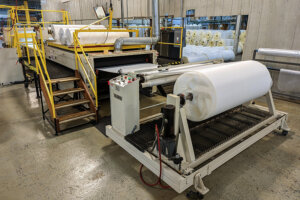Why Use a Hot Roll Laminating Machine

What is the difference between hot and cold roll laminators?
Let’s get into the differences between these two processes.
Typically, we use a hot roll laminating machine for pressure-sensitive materials. If you need a super clear finish, hot laminating may be the right option for you. This is because the processes rely on heat to activate and melt the adhesive of laminating film, bonding whatever material you’re working with. We end up with a strong seal, which protect documents from contaminants including dust, dirt, and moisture, as well as damage including creases and tearing. Great!
With a hot laminator machine, we can work with glossy paper products like photographs and artwork. We can also tackle more diverse materials, such as laminate, with a variety of different heat settings. There’s a good price-to-performance ratio with the materials we use for hot roll lamination.
Cold roll laminators, on the other hand, protect thermal sensitive materials more vulnerable to heat damage. The cold lamination process relies on pressure, pushing the materials together to create a protective coating without creases. Each cold laminate machine has two rollers, and we apply the pressure to the rollers.
With these roll laminators, there’s less prep and training required. They’re low-maintenance and require less setup time–and in turn, they typically work more for small projects. Think ID cards, business cards, and photographs. One of the things we love most about this option is that it’s bubble-free. The final results are smooth and look perfect, which is exactly what you want when you’re working with laminate. Plus, cold lamination creates a matte finish, which makes it less prone to reflections and glares. This makes it ideal for products that tend to be in brighter lighting on a regular basis.
What is a hot roll laminating machine used for?
We touched on the hot roll laminating process above–but how can we apply it in practical terms?
The main point of this lamination is protection. Important documents can be prone to damage–from heat, tears, general erosion, dust, water, and more. When a product is properly laminated, you don’t have to worry about these issues as much. Additionally, lamination retains the flexibility of the initial product (albeit with minor restrictions). In other words, you can still keep it in the same locations and organizational structures as you did prior to lamination. It’s simply safer.
Additionally, the lamination process ensures that you’ll still be able to read and process these documents in the same way you did before. At the same time, if you’re looking for embellishments, hot roll lamination can offer exactly what you’re looking for. However, we maintain the contents of the original document prior to lamination. In some cases, applying embellishments through lamination rather than other techniques is easier and more time-efficient.
Some of the other products we use a hot roll laminating machine for include: calendars, caution signs, brochures, equipment tags and procedures, ID badges, instructional manuals, business cards, construction permits, and much more.
Is it better to have a hot or cold laminating machine?
One machine isn’t truly better than the other–however, one machine typically suits different projects better than others. The question is, which type of thermal laminating machine is right for you?
As we previously mentioned, cold roll laminating machines usually work better for smaller batch orders. For that reason, you’ll often see these machines used by smaller businesses, or even sometimes on an individual basis. It’s easier to use and requires less maintenance and preparation (which saves time). Of course, the catch is that this lamination typically applies less durable lamination. This isn’t necessarily a bad thing–like we said, it requires less investment, and still works perfectly for certain smaller scale products. However, you should make this consideration before choosing cold roll laminators. Additionally, remember that the cold roll finish usually comes out matte. If a matte finish doesn’t work for your purposes, don’t choose this lamination.
On the other hand, a hot roll laminating machine suits larger scale projects better. In general, this machine is what we would denote as a large laminator. While a hot roller machine often requires more practice, the results are more durable than those you’ll get through cold lamination. Plus, while the general setup and maintenance for cold lamination machines require less time, the actual process for hot lamination is faster. A hot laminator covers more materials, beyond simply paper or similar products. The price-to-performance ratio also means hot laminators are more cost-efficient in respect to the scale of the project. You also have access to a greater variety of finishes–matte, glossy, and silk.
In general, if you’re planning to scale up or operate an expanding or mid-to-large business, we would project that hot lamination likely accommodates your needs more than cold lamination will. Know your needs before you decide.
What else do I need to know?
We can get into more specifics–such as how to outsource the processes, as well as what a third-party manufacturer can do for you when you need an industrial roller. Get in touch with CTI here or call us at 419-924-5566 to get the straight talk you need. Selecting the right lamination process and options doesn’t have to be difficult. You just need the right consultants on your side!
- << < Previous Post
- 1
- 2
- ...
- 4
- ...
- 241
- 242 Next Post > >>

